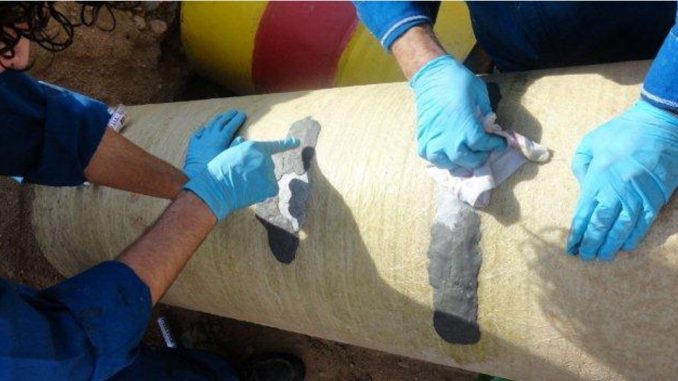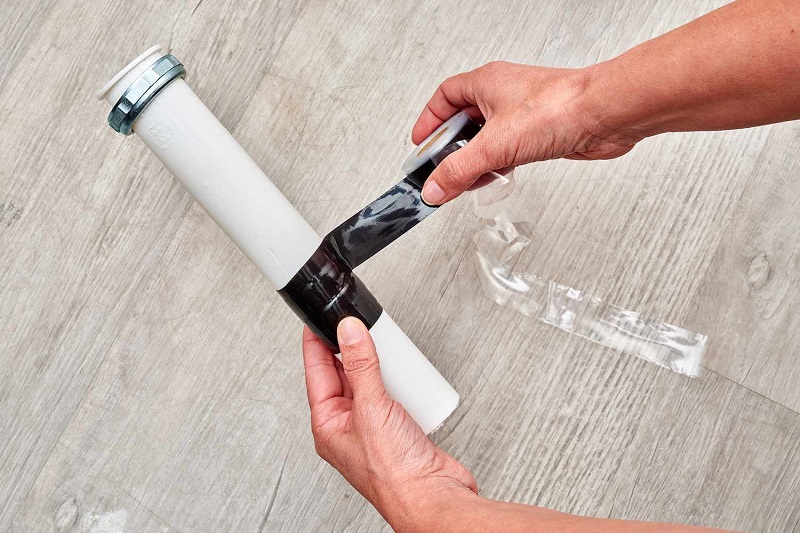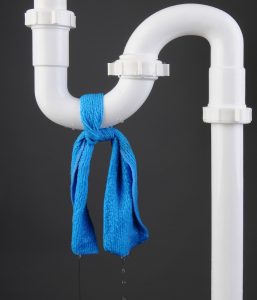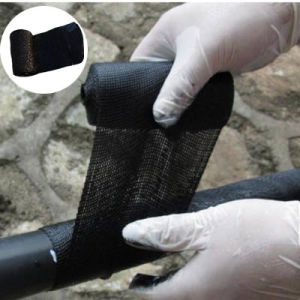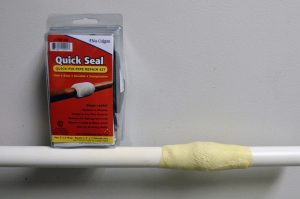How to fix a hole in plastic water pipe? You can fix a hole in a plastic pipe by applying epoxy putty and sealant spray. Alternatively, you could wrap the spot using rubber tape, silicone tape, fiberglass resin cloth, or tape. Another solution would be to replace the section of the piping with the hole.
Plastic water pipes are not only impervious to rust but also corrosion. Therefore, compared to water pipes made from non-plastic materials, plastic pipes could last up to 100 years. However, over time, these pipes may develop holes that you must fix immediately to prevent expensive repairs.
So then, how do all these methods work? Stay right here to find out this and much more.
Ways to Fix a Hole In Plastic Water Pipe: At a Glance
Below, we will briefly look at the different methods for fixing a hole in a plastic water pipe.
| No. | Different Methods | How to Fix (Steps) |
| 1. | Epoxy Putty | Apply the putty to the hole |
| Let it cure for at least 10 minutes | ||
| 2. | Rubber Tape & Hose Clamps | Wrap the tape around the hole |
| Install a few hose clamps over the tape | ||
| Tighten the clamps | ||
| 3. | Fiberglass Resin Cloth | Wrap the cloth around the hole |
| Activate the resin in the cloth | ||
| Sand and paint the surface after the resin is cured fully | ||
| 4. | Fiberglass Resin Tape | Wrap the tape around the hole while the surface is wet |
| Let the tape cure for 15 to 30 minutes | ||
| 5. | Silicone Tape | Cover the hole with as much silicone tape as you can |
| Test if the hole is still leaking | ||
| 6. | Sealant Spray | Spray the sealant onto the hole |
| 7. | Replacement | Cut the section of the pipe with the hole |
| Fit a new piece of plastic pipe into the cut section |
What Causes a Hole in a Plastic Water Pipe?
Before we discuss how to fix a hole in plastic water pipes, let’s first find out the causes of the hole. These include:
- Punctures
Sometimes, friction from debris and rocks under the soil can puncture plastic water pipes, causing a hole.
- Extreme Cold Temperatures
Plastic water pipes may get damaged or weak due to chilly winter temperatures. The water inside the line may freeze and expand, causing a hole.
- High Water Pressure
When the water pressure is too high, it can strain the plastic water pipes. Eventually, the water may create an opening so it can escape.
- Excessive Sunlight
If the pipes are above the ground, they may become brittle due to prolonged exposure to direct sunlight. With time, holes may develop.
How to Fix a Small Hole in a Plastic Water Pipe?
Several methods exist to fix a hole in plastic water pipes; some are more effective than others. Read on to find out what these methods are.
Method 1: Epoxy Putty
This is a malleable paste-like adhesive that is waterproof and non-toxic. However, this method only offers a temporary fix since the putty is designed to form a semi-permanent bond.
Here are steps on how to fix a hole using epoxy putty:
Step 1: Switch off the water supply from the leaking water pipe.
Step 2: Clean and dry around the section with the hole.
Step 3: Prepare the putty according to the manufacturer’s instructions by kneading the resin and hardener together.
Step 4: Apply the epoxy on the hole by pressing it down on the edges and leave it for 10 minutes to cure.
Step 5: Check if the hole is sealed by turning on the water supply and allowing water to move via the pipe.
Method 2: Rubber Tape & Hose Clamps
Rubber tape can patch, bond, and seal virtually everything, including a hole in plastic water pipes. When wrapped around a surface, the tape creates a strong, secure, and water-resistant bond. However, this method is best suited for fixing small holes temporarily.
Check out these steps on how to use the rubber tape to fix the hole:
Step 1: Clean and dry the affected area.
Step 2: Wrap your rubber tape around the hole.
Step 3: Then, get a few hose clamps and place them over the hole.
Step 4: Tighten the clamps to secure the rubber tape to the plastic pipe.
Method 3: Fiberglass Resin Cloth
Fiberglass resin cloth is a woven fabric that is 100% waterproof and ideal for many repair projects. Unlike the methods discussed above, it offers a more permanent fix.
Below is a step-by-step guide on fixing a hole in a plastic water pipe using fiberglass resin cloth.
Step 1: Clean away dirt around the hole and lightly sand it.
Step 2: Get the fiberglass resin cloth and wrap it around the hole, pressing it hard into place.
Step 3: Then, shine a UV light directly onto the fabric for at least 15 minutes to activate the resin.
Step 4: Sand and paint the surface once the fiberglass resin cloth is fully cured.
Method 4: Fiberglass Resin Tape
Fiberglass resin tape is a narrow cloth strip with woven edges but no adhesive backing. But unlike fiberglass cloth, the tape is ideal for fixing small holes in plastic water pipes. This is because it offers a short-term solution.
Following are steps on how to use fiberglass resin tape to seal a hole in a plastic water pipe:
Step 1: Wipe clean the area on the plastic pipe with the hole using a damp cloth.
Step 2: Enfold the tape around the tube to cover the hole while the surface is wet.
Step 3: Leave the tape to cure for 15 to 30 minutes.
Method 5: Silicone Tape
This is a self-fusing tape which means it is self-bonding, forming a strong and permanent bond. And like fiberglass resin tape, it does not have adhesive. When used to fix a hole in a plastic water pipe, the tape creates a moisture-proof and air-tight seal.
Check out the steps below on how to use the tape to fix small holes:
Step 1: Wrap the hole tightly using the silicone tape, covering a little to the right and left of the area.
Step 2: Test the pipe for leaks by letting water move through.
Step 3: Wrap more silicone tape if there is still a leak in the hole.
Method 6: Sealant Spray
A spray sealant offers an instant waterproof seal on virtually any surface, including plastic water pipes. The sealant is designed to seep into the holes, forming a rubberized surface once dry to block out water and moisture.
Check out these steps on using a sealant spray to fix a hole in a plastic water pipe.
Step 1: Clean the area of the pipe with the hole.
Step 2: Shake the can for at least 60 seconds before spraying an even coat of the sealant onto the hole.
Step 3: Let water move through the pipe to test if the hole is sealed completely.
Method 7: Replace the Section with the Hole
If the hole is too big, replacing the damaged sections with a new plastic pipe is the best way to fix it. Here are simple steps on how to replace the pipe:
Step 1: Turn off the water to the pipe at the main water supply.
Step 2: Cut the section of the pipe where the hole is about an inch to the left and the right using a hacksaw.
Step 3: Drain any excess water from the pipe.
Step 4: Put some PVC primer solvent inside the replacement plastic pipe. Also, apply the solvent to the outside of the existing plastic pipe.
Step 5: Next, apply glue around the inside replacement pipe and outside of the existing pipe.
Step 6: Fit the replacement pipe into the hole and hold it firmly for 10 seconds to build a strong bond.
How Do You Prevent Holes From Forming on Plastic Water Pipes?
You could take several steps to prevent or minimize holes in plastic water pipes.
- First, you should regularly inspect the above-ground pipes during different weather and temperature elements.
- Also, ensure you check the water pressure regularly.
- In addition, we suggest you insulate the pipes to protect them from freezing during the chilly winter season.
- More so, it would help if you painted the water lines to protect them from excessive sunlight.
Conclusion
While there are several causes of a hole in a plastic water pipe, fixing the hole is also easy. Besides using epoxy putty, you could also use silicone tape, sealant spray, and fiberglass resin tape to fix the hole. In addition, you could seal the hole using fiberglass resin cloth or rubber tape.
However, if you want a more long-lasting solution, the best solution would be to replace the section of the pipe with the hole. Having said that, you can prevent the holes from developing in the first place by insulating the pipes. You could also paint the pipes to protect them from too much direct sunlight.


